#he's literally the embodiment of tactical brilliance.
Explore tagged Tumblr posts
Text
carlos sainz jr. i fucking adore you. from a puncture in the first lap to maintain that p3 all while fighting TWO MCLARENS (leaving enough gap between piastri and himself, holding lando back), ensuring he managed his tyres, while big brain strategizing about pit stops and how he can let charles have the win!
#a whole ass essay on thie will be probably up tommorow#but I'm so sick and tired of people underestimating carlos and acknowledging him only when it benefits them 😭#he's literally the embodiment of tactical brilliance.#some people are just too big of a hater to understand this.#but objectively he's fantastic do you understand how much thoughts have to be thunk to piece all of this#like managing his own race without pitting as well as predicting how it would affect charles....#carlos sainz jr#formula 1#monaco gp 2024#they can never make me hate you
49 notes
·
View notes
Text
“Greyhound” On Target: A Review Of Tom Hanks’ New World War II Naval Drama

Coming on the heels of the successful 2019 naval epic “Midway,” Tom Hanks’ equally intense and exciting “Greyhound” is on target as it chronicles a harrowing 52-hour running battle between an Allied supply convoy’s escorts and a German U-Boat pack across a remote, undefended region of the North Atlantic during World War II.
The fictional story is set in February 1942 and follows the USS Keeling (DD 548), a U.S. Navy Fletcher-class destroyer codenamed “Greyhound,” and its captain, Commander Ernest Krause, as he leads a multinational escort fleet comprising his vessel, the two British destroyers Harry and Eagle, and the Canadian Corvette Dickie. Their mission is to protect the 37-ship Convoy HX-25 from Halifax to Liverpool as it runs the U-Boat gauntlet.
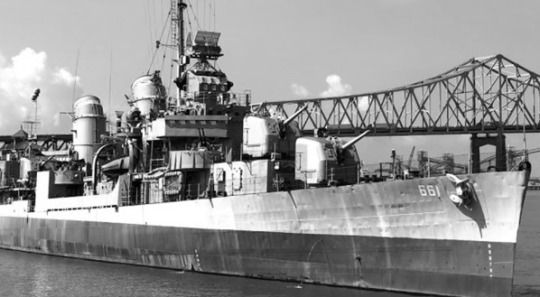
Greyhound was shot aboard the USS Kidd, pictured above.

The USS Kidd stands in for the fictional USS Keeling (Greyhound) in the movie.
This was a daunting task during that early phase of the war, with America having only entered it two months before with a small, unprepared navy and obsolete technology. The Keeling’s radar and sonar are balky, its window wipers freeze up, it’s low on fuel, and the warship does not carry enough depth charges for the job. Moreover, the wintry heavy seas of the North Atlantic are unforgiving, forcing Krause and most of his crew to fight on the Keeling’s weather deck and weapons stations while soaking wet and shivering cold. There is no air cover either since that part of the deep ocean was beyond the reach of Allied land-based anti-submarine aircraft. Naval planners formally named it the “Mid-Atlantic Gap” but sailors and merchant mariners simply called it the “Black Pit.”
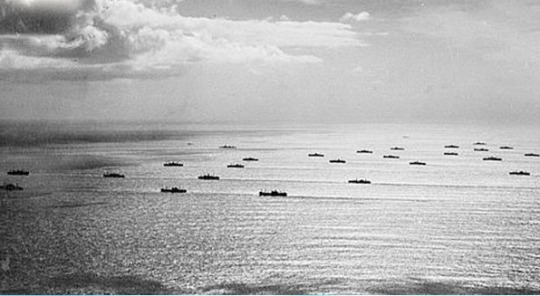
An Allied convoy traverses the Atlantic in November 1942.

An Allied convoy crosses the Atlantic Ocean in the Tom Hanks movie.
While contending with the U-Boats, his ship’s limitations, and the environment, Krause himself also has to resolve an inner struggle with his personal frustrations, insecurities, inexperience, and even guilt in killing his German adversaries. In his forties, over-the-hill, and still a low ranking officer, he was the victim of the peacetime Navy’s practice of “fitting and retaining” competent officers by shuffling them from one administrative assignment to another during the 1920s and 1930s without ever assigning them to a sea command. Therefore, he is acutely aware that all eyes in the convoy are upon him since this is not only his first command but also his first combat crossing of the Atlantic.
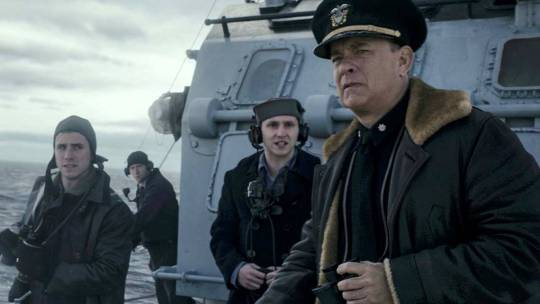
Krause is emotionally hurting too since, in an early flashback, his girlfriend Evelyn had refused to move from San Francisco to the East Coast with him and accept his marriage proposal. Her explanation that “the world has gone crazy” and that she wanted to wait until they “could be together” rang hollow. What she was really worried about was getting married and then quickly becoming a widow, which a heartbroken Krause understands and accepts. As a consolation, she then gives him a toy destroyer to commemorate his first command at sea and a pair of monogrammed slippers to remember her by.
Krause perseveres under these multiple burdens by drawing upon his devout Christian faith, daily prayers, and a handbill that he has posted on the mirror in his cabin quoting Hebrews 13:8 from the Bible—“Jesus Christ the same yesterday, and today, and forever.” Ultimately, Krause proves to be quick thinking, stalwart, and tactically brilliant, as seen during his first encounter with a U-Boat. Despite his problems, he falls back upon his training and intuition and successfully deduces his enemy’s circular dogfighting path to port, orders a rapid “right full rudder” to cut it off, and then destroys it with depth charges, much to the delight of his crew and British peers. While his men are celebrating their first kill, he takes no joy in his achievement, quietly mourning the deaths of the 50 German souls he had just sent to the bottom of the Atlantic.

This was just the beginning of the Keeling’s ordeal. Over the next two days, Krause, his crew, and the other escorts fight an increasingly desperate series of engagements with the U-Boats, which penetrate the thinly-stretched destroyer screen and pick off several of the merchantmen as they cross the Black Pit. The lead U-Boat commander, calling himself “Grey Wolf,” taunts the Allies with blood-curdling threats and predictions of their doom over the open radio frequencies. “You and your comrades will die today,” the mysterious German skipper warns Krause in his final rant.
The Grey Wolf’s cat-and-mouse game with the Keeling is both deadly and personal but Krause eventually succeeds in his mission though not without loss. Sleep-deprived and exhausted, Krause runs his feet bloody raw during his non-stop scrambling back and forth across the Keeling’s bridge and weatherdeck. He can barely walk before the climactic battle with his nemesis and finally replaces his stiff leather shoes with Evelyn’s lined, warm slippers, not only easing his physical pain but also comforting himself with her virtual presence in the midst of combat.
Hanks’ story of Krause follows closely that of Cecil Scott Forester’s original character in the 1955 novel The Good Shepherd, right down to the sonar and radar bearings, the same orders, and the same combat maneuvers, blow for blow, against the same U-Boats. One notable difference though is that Forester’s Krause is named “George” and he is much more damaged psychologically than “Ernie” in Hank’s film. In the book George Krause suffers overwhelming guilt from a broken marriage, his wife’s infidelity, and their divorce, as well as the professional shame of a stalled career and passed over promotions. He also has to deal with the awkwardness of commanding more experienced crew members and Allied captains in the convoy.
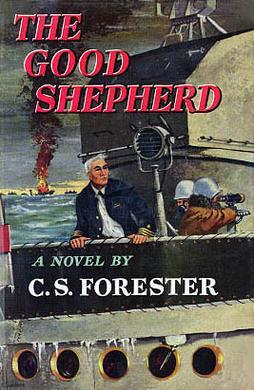
However, both George and Ernie reveal quiet inner strength that allows them to overcome their adversity and to win both their battles and the respect of their sailors. Each is “the man alone,” as Forester liked to call his prime characters, such as Horatio Hornblower, for whom the author is most famous. Indeed George and Ernie embody many of the introverted Hornblower’s traits, including his introspection, his dedication to duty, his discipline, his command brilliance, and his loneliness. Commander Krause is in effect Captain Hornblower in a World War II naval-setting, without the chronic sea sickness.
In his many books Forester (real name Cecil Louis Troughton) went to great lengths to portray his characters, their appearance, equipment, and customs and traditions in minute detail based on meticulous historical research. In 1943, the author was able to sail as a civilian aboard the Royal Navy light cruiser HMS Penelope as it patrolled the Mediterranean Sea. During that experience, he learned first-hand how a ship-of-war operated and made several key naval acquaintances who later served as advisors and proofreaders for his books, including the The Good Shepherd, as reflected in its exquisite accuracy.
Tom Hanks took Forester’s historical approach to heart in making Greyhound and consulted with Naval History Dr. Craig L. Symonds of the Naval War College and Marine Historian Gordon H. Laco to ensure that the film’s technical details and crew interactions and behavior were as historically accurate as possible. He toured the U.S. Naval Academy and filmed as much as he could aboard the USS Kidd (DD 661), the only remaining Fletcher-class destroyer still in existence in its World War II configuration, currently moored as a ship museum in Baton Rouge, Louisiana. According to Symonds, one point of contention was Hanks’ desire to portray a more familiar relationship with Mess Mate George Cleveland, a black sailor who feeds and looks out for his captain when not handling ammunition at his General Quarters gunnery station. Symonds told Hanks that this would have been impossible in the segregated World War II-era Navy which was dominated by hard-nosed, old school, class and race-conscious officers. Hanks resisted but Symonds insisted, so the producer met the historian half-way and split the difference in Greyhound, portraying Krause’s relationship with Cleveland as gentle but firm.
Other details are more authentic, from the uniforms and personal gear to the actual control knobs, lights, and wheels of the Keeling’s control panels and even its guns and their specific rates of fire. The burial at sea scene was also accurately done too, based on Navy regulations and customs of the period, which Hanks researched from the original archived manuals.

The shootout between one of Grey Wolf’s surfaced U-Boats and the Keeling and Dickie at mid-film is based on an actual close-quarters brawl between the Canadian destroyer HMCS Assiniboine and U-210 that occurred on August 6, 1942 while the Assiniboine was escorting Convoy SC-94. Both vessels had encountered each other by chance in the early morning mist and fog. Historian Gordon Laco described the action to USA Today, noting that “They were literally blasting each other with pistols, rifles, revolvers. The cook even came out of the galley and threw an empty case of Coca Cola bottles down the submarine hatch.”
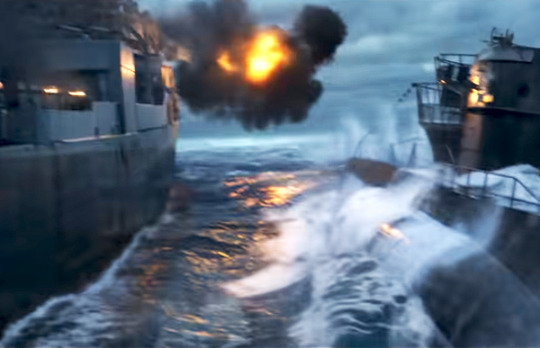
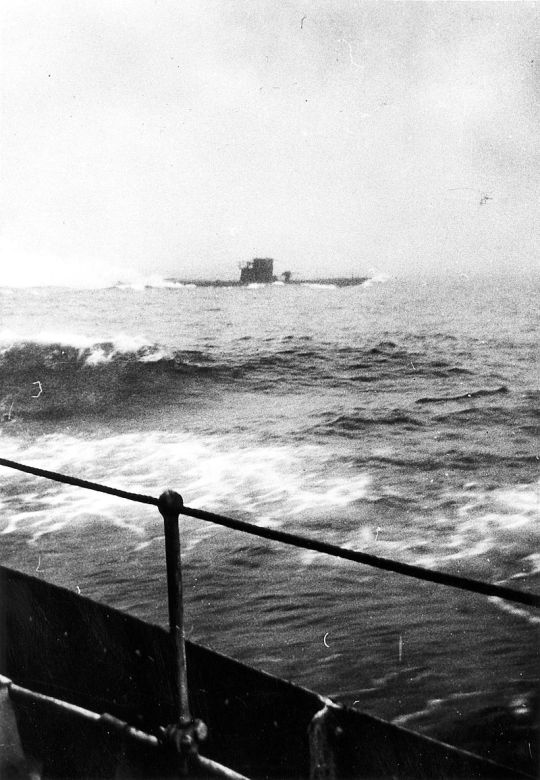
U-210 photographed from Assiniboine's deck, 6 August 1942
There are a few inaccuracies though that should be noted. The USS Keeling itself never existed, since destroyer (DD) hull #548 was canceled before construction, and the first of the Fletcher-class warships did not launch until May 1942, three months after the events of Greyhound. It would have been more authentic to show the Keeling as an earlier Mahan-class destroyer, as Forester originally wrote it, but the Fletcher-class was likely chosen by Hanks because of the availability of the Kidd in Baton Rouge for filming. Further, radar and sonar technology was not quite as advanced as portrayed in the film, even though the U.S. Navy had been participating in convoy operations since early 1941, with the USS Reuben James (DD 245) sunk by U-552 near Iceland on October 31 of that year.
And although the Type VII U-Boats were the most widely used of the war, with 703 built, generally they would not have fought Allied warships on the surface in broad daylight unless it was absolutely necessary, the chance historical battle between the Assiniboine and U-210 notwithstanding. Considering that a U-Boat’s chance of avoiding detection and survival was already slim, stealth was its key weapon and the darkness its ally, as was portrayed in 1981’s German film ‘Das Boot.’

German U-boat U-848 is attacked by a U.S. Navy Consolidated PB4Y-1 Liberator in November 1943.

A German U-boat is besieged in the Tom Hanks Greyhound movie.
Additionally, it would have been suicidal for a U-Boat commander to openly taunt destroyers on open frequencies as shown in the film and thus reveal their presence and locations. Forester did reference one instance in The Good Shepherd in which a British officer refused to send Krause an important message over voice radio because “Jerry’s been on this circuit more than once during the night. He has an English-speaking rating who chips in with rude remarks, and I wouldn’t like him to hear this.” This is undoubtedly the source of Hank’s plotline with the Grey Wolf’s rather childish howling, which is historically implausible, since German naval officers of the period were thorough professionals and considered to be the elite of the Kriegsmarine. They tended to follow Kriegsmarine regulations to the letter, which required strict radio silence while stalking and attacking convoys. The submarine profession is not called the “silent service” for nothing. Consequently, there is no historical record of such taunting ever occurring, even though there are a couple of recorded incidents of U-Boats “blinking” distant destroyers with their signal lamps after dark.
And while we do catch a brief distant glimpse of a brave U-Boat captain fighting his submarine from his conning tower and his crewmen manning its guns during the Keeling-Dickie surface battle, it is also unfortunate that Hanks otherwise chose to depict the Germans collectively through the disembodied, sneering voice of the Grey Wolf, particularly in light of their more realistic portrayals in previous classic films like Das Boot and The Enemy Below.

Those nitpicks aside, Greyhound is an excellent film depicting the often neglected “Battle of the Atlantic,” which was in fact the longest continuous and most complex military campaign of World War II, running from 1939 to 1945. British Prime Minister Winston Churchill himself later wrote that “The only thing that really frightened me during the war was the U-boat peril. I was even more anxious about this battle than I had been about the glorious air fight called the 'Battle of Britain'.” Indeed, 3,500 Allied merchant ships and 175 warships were sunk in the Atlantic, with 36,000 merchant mariners losing their lives, while 783 U-boats were sunk with 28,000 out of 39,000 German submariners perishing by war’s end.
Up to now, there have only been a few films focused on this crucial theater of the war, perhaps because it was previously difficult to capture its vastness and complexity before the advent of current CGI technology made it possible. Among the most notable from a surface warfare perspective are The Cruel Sea (1953) and The Enemy Below (1956), while submarines and submariners are the focus of Das Boot (1981), U-571 (2000), and In Enemy Hands (2004). And although current reviews of Greyhound are mixed, with many reviewers (perhaps spoiled by Midway) complaining about the film’s short length at 90 minutes and its lack of character development, and without any German voices except that of the generically evil Nazi Grey Wolf, they miss the point. The Allied navies and the merchant mariners they protected acted in concert as a team, and because of that “all hands job”, as portrayed in the 52-hour snap shot of Greyhound, the Grey Wolf howled his last howl, portending “Wolf” Hitler’s last howl four years later in April 1945. That too was an “all hand’s job.”
Working on your next award-winning documentary or binge-worthy historical fiction drama? Our team can help you create media so captivating your viewers can’t stop watching. How? By giving you the details you need to turn casual browsers into super fans. From screenplay creation, to costuming, to final review, SJR Research can bring immersive accuracy to your project every step of the way. You can browse SJR Research’s service on your site at SJR Research.
0 notes